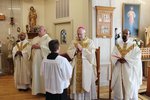




BURRILLVILLE — St. Theresa Catholic Church and Shrine recently marked the 99th anniversary of its founding.
St. Theresa Parish, one of the earliest shrines dedicated to St. Theresa of Lisieux, was established in 1923, with the approval of Bishop William Hickey, shepherd of the Diocese of Providence, in order to serve the needs of the growing Catholic community of Nasonville village in Burrillville. Today, the shrine is part of a larger faith community, composed of Our Lady of Good Help Parish, St. Theresa Shrine and St. Patrick’s Parish.
It was at the recommendation of Bishop Hickey that the parish dedicate itself to St. Theresa, whose canonization process had begun only nine years earlier, and who was elevated to the status of “venerable” only two years before the parish was founded. It wasn’t until 1925 – two years after the parish was established – that St. Theresa was officially declared a saint. Over the course of its history, many miracles are believed to have taken place among pilgrims to the church.
The anniversary was celebrated on Sunday, August 21, beginning with a 10:30 a.m. Mass, in which Auxiliary Bishop Robert C. Evans served as celebrant. Concelebrants included Father Jose Parathanal, C.M.I., the pastor of St. Theresa and Our Lady of Good Help parishes, and Fr. Joseph Mapilamattel, C.M.I., the assistant pastor.
Many of the altar servers who assisted in the Mass were members of the diocese’s Special Religious Education community at St. Patrick Parish in Providence.
At the beginning of the Mass, Father Parathanal welcomed Bishop Evans for the special occasion.
“Thank you so much and welcome to this community, to this wonderful place, which is the first shrine in the world [dedicated to St. Theresa of Lisieux],” Father Parathanal said. “I welcome you to this great celebration of the 99th anniversary of the Shrine.”
“I also welcome each and every one of you at this time,” he continued, speaking to a full congregation containing pilgrims from both throughout the state as well as from other parts of the country.
“I know that you have come from many places. And so I welcome each and every one of you to this Holy Mass and the celebrations of this day.”
In his homily, Bishop Evans emphasized the necessity of humility as the greatest tool in cooperating with God’s Plan.
“Humility is one of the most important virtues,” Bishop Evans preached, “because Jesus said, ‘Blessed are the meek, the humble, for they shall inherit the earth.’”
The bishop said that humility leads to authentic love for God and neighbor, which is the defining feature of the Christian life. He went on to note how St. Theresa’s belief in the Little Way – doing ordinary things with great amounts of love – was an example of such humility in practice.
The Mass ended with the exposition and veneration of St. Theresa’s relics. The relics were placed on the altar as Bishop Evans blessed them with incense. After the closing procession, those in attendance could approach the relics to pay their respects and bring their prayer intentions.
Mass was followed by a communal praying of the Rosary. Participants took part in a procession throughout the campus of the Shrine. Prayers were recited in English, French and Spanish. Participants walked along a path on which the Shrine is planning to build a Rosary Walk.
The Rosary was followed by lunch offered by the Shrine, before the Scala Sancta (Holy Stairs) devotion. The Holy Stairs in Rome are a marble staircase believed to be the stairs climbed by Our Lord when he was brought to Pilate’s palace in Jerusalem during the Passion. These stairs were brought to Rome from Jerusalem by St. Helena in the fourth century, and replicas of these stairs are found at churches throughout the world. Participants in this devotion will climb these stairs on their knees while saying a series of prayers meditating upon Our Lord’s Passion and Death.
The Holy Stairs devotion was followed by the Stations of the Cross. Each individual station was represented by a large rock structure imprinted with the relevant scene from Our Lord’s Passion. Brief meditations on the various stations were coupled with excerpts from the book To the Priests: Our Lady’s Dearly Beloved Sons, a book by the 20th century Italian priest Father Stefano Gobbi inspired by a series of visions he had of the Blessed Virgin Mary. During the ceremony, participants held a rose, a symbol of St. Theresa, and at the end of each station, a petal from the rose was torn off and left at the station.
The day’s celebration ended with Adoration of the Blessed Sacrament and Benediction, led by Father Parathanal. Adoration was accompanied by the recitation of the Divine Mercy chaplet.